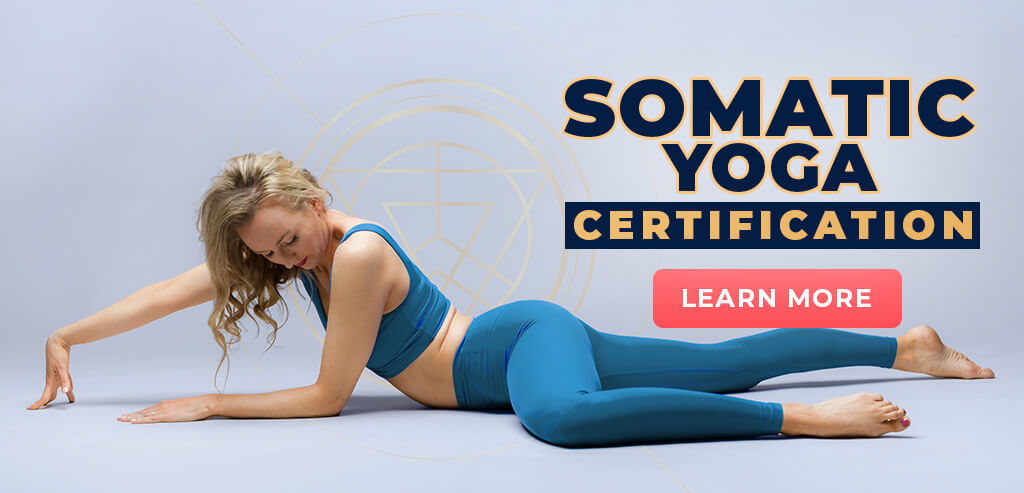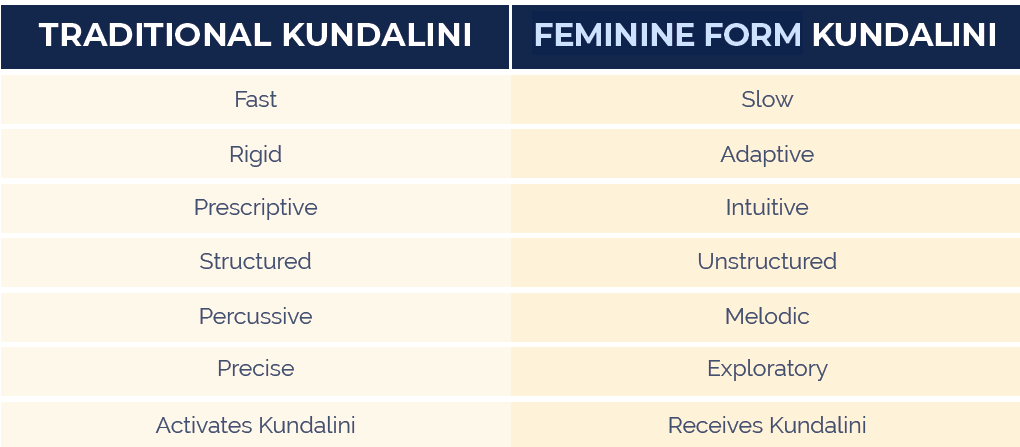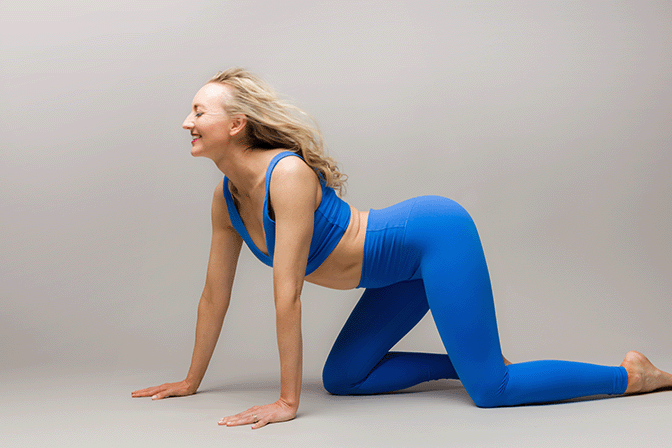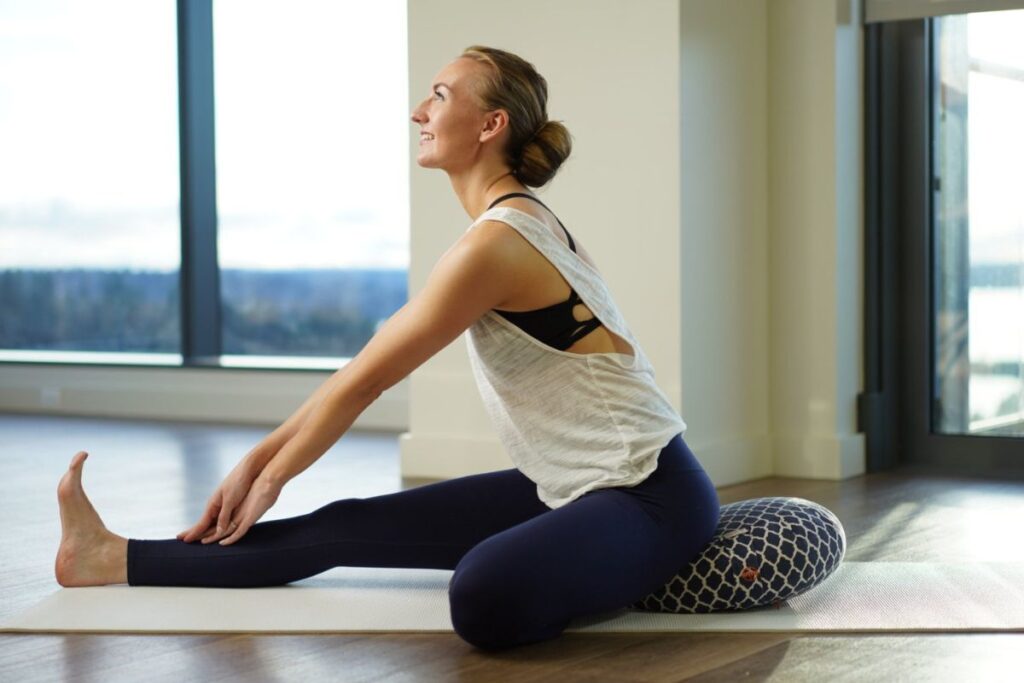Kundalini yoga is a yoga practice that I hold near and dear to my heart. It has been one of my favorite practices for years. But after working so long with kundalini kriyas, breathing practices, and energy channels; I realized that this practice has become extremely masculine.
We live in a world of polarity yet our day to day lives are riddled with masculine energy and shove Divine Feminine energy aside. Does that sound like balance to you? Me neither.
But what if we could reach kundalini awakening in a different way? What if instead of using pressure, tension, stress and friction to force this life energy up, we could seduce it into moving in a way that is easeful and pleasurable? If you tap into your feminine side and the Divine Feminine that lives within you, you can.
Understanding Kundalini Energy
Kundalini energy is a powerful, dormant force located at the base of the spine, often described as a coiled snake or serpent. In yogic philosophy, it represents the Divine Feminine energy, or Shakti. Kundalini yoga focuses on awakening this energy. When awakened, kundalini energy rises up Sushumna Nadi through the chakras, connecting you to collective consciousness and spiritual enlightenment. This energy is essential for balance and harmony in the body, bringing the ultimate union of both the masculine (Shiva/consciousness) and feminine (Shakti/life force) aspects of existence together.
I don’t want you to think of kundalini as just a mystical concept, but a practical pathway to self-realization. Rooted in the wisdom of goddesses like Parvati, the incarnation of Adi Shakti and Divine Mother/Goddess of Supreme Universal Power in the Hindu tradition, this energy embodies unity, transformation, and unmanifested potential.
This cosmic energy is your untapped potential. It is your birthright. I believe that we as human beings are all born with our Kundalini Shakti fully awakened. It’s the stressors/experiences of life and suppressing your true nature that then put it to sleep. Kundalini yoga works to awaken this subtle energy through poking and provoking polarity.
As we embrace the values of masculine and feminine energy in yoga and daily life, and learn to work with both of them, we contribute to a more balanced world. One where our overly masculine society is brought to balance by the feminine being fully integrated at all levels. Fostering a new paradigm of harmony and wholeness. This is why feminine energy traits like compassion, nurturing, and authenticity are vital for personal transformation and the evolution of consciousness.
Start awakening your feminine energy now with this class:
What Is The Feminine Energy Of The Kundalini?
The feminine energy of Kundalini, a.k.a. Shakti energy is the dynamic, creative force that lives inside you. It is essential for balance and harmony in the body. If you’re familiar with the story from Hindu tradition, then you know that without Shakti, Shiva cannot awaken. This suggests that your spiritual awakening is not just about reaching higher consciousness, but is a dance of Divine Feminine awakening as well.
Shakti life force energy sits dormant at the base of your spine patiently waiting for you to awaken her so that she may move up and meet her love, Shiva(consciousness). To create balance and harmony within your body. To rise through the chakras and have the ultimate union of the masculine (Shiva) and feminine (Shakti) aspects of existence. When you awaken your Kundalini Shakti you start the process of deep transformation of coming into pure consciousness. Leading to higher states of awareness and inner peace. Integrating these two energies, masculine and feminine/left and right sides, is a crucial part of spiritual growth and awakening.
Some key points about this Divine Feminine Energy:
- It is embodied through goddess traditions like Bhairavi and Kubjika, symbolizing unity, the reconciliation of opposites, and the path to wholeness.
- The values of compassion, self-sacrifice, and nurturing are innately feminine and are a critical part of personal growth and the evolution of collective consciousness.
- Integrating the feminine at all levels of life—within yoga, relationships, and society—creates a more balanced world, fostering a paradigm where intuition, care, and interconnectedness guide the transformation of both individuals and communities.
Download My Trending Kundalini Dance Party & Transform Your Energy in Under 10 Minutes 💃

Download My Trending Kundalini Dance Party - Transform Your Energy in Under 10 Minutes 💃

Kundalini Yoga and Breathwork for Awakening Feminine Energy
Traditional kundalini yoga is a practice that systematically activates energy throughout the body, integrating movement, breathwork, and sound to transcend mental limitations and expand consciousness. It forces the energy up and out through pressure, tension, and friction, stimulating all systems—the nervous system, endocrine system, and circulatory system—and creating a powerful energetic shift. This often leads to feelings of profound self-awareness and, ultimately, spiritual awakening.
If you’ve practiced kundalini yoga, you know its often a dynamic combination of chanting, singing, repetitive movements, deep meditation, and breath control (pranayama). These things work together to unlock blocked energy and raise it through the chakras. Breathwork, in particular, plays a vital role in awakening kundalini energy. Through regulating the breath you calm the mind and relax the body allowing kundalini to move.
One particular breath practice that works to unite the masculine and feminine energies is alternate nostril breathing. By rhythmically breathing through the left nostril and then the right nostril you are activating both sides of the brain. The creative and the logical; the masculine and the feminine. This rhythmic, intentional breathing, creates a direct pathway for energy to flow freely, supporting both physical vitality and deep inner transformation.
While the traditional model of kundalini is incredibly valuable and has many benefits, there is another way to work with this energy that is equally as valuable. This is the feminine form. Where you’re not just raising energy but actually moving energy for your whole body in a way that feels grounding and nourishing. Where you use the kundalini postures as a frame for self reflection rather than an instruction manual.
How To Make Kundalini Yoga More Feminine
Kundalini by nature is poking and provoking polarity. Poking masculine and feminine poles in order to get kundalini to rise. It uses the downward force of ida and pingala to force kundalini up. This is a more masculine way of moving energy and kundalini yoga has become increasingly masculine over the years. The postures focus on rigidity over fluidity. On structure and direction rather than intuition and movement. So how do we honor the kriyas but still inject a more feminine approach?
We need the feminine Shakti energy to be able to hold the Shiva, masculine energy. Instead of forcing the kundalini to rise, you’re dancing with it, like Shakti danced to awaken Shiva. You don’t need rigidity for every single pose to move this life force energy. You can seduce the energy to move through movements that are pleasurable and natural. And the best part is almost any kriya can be done with the creative power of the feminine.
Tips to make your kundalini practice more feminine:
💎 Grace: Add grace to your movements by softening your face, lifting the heart and exposing the throat. Think of moving like a ballerina.
💎 Undulate: Instead of percussive breath and rigid motion you move more fluidly; moving in smooth wave-like motions.
💎 Express: The feminine wants to be felt and seen, to experience and express. What are you yearning for right now? Express it. Go off script and inject your desires into the posture. Whether that’s emoting or adding sound, or going in a different direction. Follow what brings you pleasure.
💎 Spiral: Move the body in a spiral motion adding small twists or opening and closing the chest. Instead of a standard shoulder shrug just add an element of curvature for example.
💎 Slow Down: Keep it simple, slow it down to be in service of yourself or whoever you are teaching. Spinal flex is a good posture to practice this with.
These can also be helpful to students who might be struggling with certain kundalini postures. The goal is to accentuate the postures and spiritual practices in a way to help you feel more embodied. Here’s a handy little chart to show you the differences between traditional and feminine kundalini. Let it guide you on how to make your kundalini practices more feminine:
Want to know if your feminine energy is in balance? Take my feminine energy quiz to find out!
Take my feminine energy quiz to get a recommended practice for balancing YOUR feminine energy 👇
Top Kundalini Yoga Poses For Feminine Energy
Below are some common Kundalini postures and tips on how to make these postures more feminine in order to move blocked feminine energy. When teaching kundalini for feminine energy/feminine form kundalini I love to weave familiar traditional postures or kriyas in with the more fluid and feminine movements. I’ve found this helps make students who practice traditional kundalini yoga more comfortable. Remember, we aren’t trying to dismiss yogic tradition, we are simply trying to honor the physical body. To recognize when we need the structure of masculine energy and fluidity of female energy and then provide that for ourselves.
Here are some examples:
1. Tune In
NOTE: This is the feminine form version of the traditional tune-in for kundalini kriyas.
Steps to Practice:
- Come to an easy seat either on your mat or a cushion. Sit tall, spine long and slowly rub the hands together.
- Bring the hands together in prayer, angling them 45 degrees away from the body with the elbows nestled into the ribs. This is more of a position of devotional reverence instead of how the arms would be in a traditional kriya.
- Exhale all the air from the body. Inhale, chant the mantra as a form of prayer/yearning “Ong Namo Guru Dev Namo” three times.
- Breathe in, expand the pelvic floor down, imagine energy moving down. Stroke the palms along the thighs to ground the energy.
Variations:
- Make this a more structured traditional tune in. See how in this post: The Adi Mantra Explained.
Benefits:
- Signifies the beginning of your practice and connects you with the vibration of creative consciousness.
Pro Tips for Yoga Teachers:
- Invite in more touch before you start. Rub the arms and tops of the legs, the backs of the hands or collarbone, before bringing the hands to prayer.
- Give students the option of whether they want a more masculine structured tune-in or a more feminine one. Ask them to listen to what their body needs at this moment.
2. Kundalini Cat/Cow
Steps to Practice:
- Come to hands and knees in a tabletop position.
- Inhale gaze forward to arch the back and draw the shoulder blades down and towards one another (Cow).
- Exhale bring chin to chest and push the floor away to round the spine (Cat) moving back and forth with a percussive breath pattern.
Variations:
- Use props like a blanket to pad the knees and wrists.
- Extend one leg long moving with the breath, inhale, extend the leg, exhale, pull the knee to the chest. You can do this with a percussive masculine breath or slow it down and make it more feminine.
Benefits:
- Improves mobility and encourages tension relief in the back as well as giving greater breath awareness.
Pro Tips for Yoga Teachers:
- Encourage students to emote; making audible exhales or releasing primal sounds.
- Ask students to move super slow through this and see how it feels in their body.
3. Spinal Flex w/ Side Bend
Steps to safely practice this posture:
- Sit in a kneeling position, either on your heels or place a cushion/block between the calves to sit on. Take the left palm to the mat, right arm comes overhead toward the left side, opening the side body.
- Breathe in as you yearn your chest/heart forward, left arm gently going back in space. Breathe out as the left arm comes forward, rounding the shoulders gently. Move back and forth with the breath then switch sides.
- Inhale, come back to center when complete.
Variations:
- Use props or sit in a cross legged position if that makes it more comfortable.
- Circle the wrists to incorporate spiral movements.
Benefits:
- Releases tension in the chest and shoulders while promoting deep relation and emotional release.
Pro Tips for Yoga Teachers:
- Encourage students to be “graceful” here. Moving like a ballerina, emphasizing the opening of the heart.
- Add touch guiding the hands down the body ending by gently rubbing the thighs or knees to ground energy.
4. Janu Sirsasana
Steps to Practice:
- Sit up tall with the legs extended in front of you. Bend one knee pulling the sole of one foot towards the opposite thigh. Continue to sit up tall.
- Inhale, take the arms overhead, and exhale hinge from the hips to fold over the extended leg.
- Rest your hands where it feels most comfortable(leg, foot, floor) while keeping integrity in the spine and hold for 1-2 minutes.
- Inhale slowly rise back to a tall seat and switch sides.
Variations:
- Bend the knee of the extended leg to accommodate tight hamstrings.
- In traditional kundalini this is usually accompanied by a breath of fire or quick staccato breath/movement.
Benefits:
- Relieves low back pain and tension in the hips while calming and grounding energy.
Pro Tips for Yoga Teachers:
- Add undulation and grace: lead with the chin opening the heart to fold over the leg and round, rolling up slowly through the spine to come back up. Move with the breath and make this pleasurable.
- Instead of using the traditional rigid structure of a standard kundalini kriya, offer students Sitali breath rather than breath of fire.
5. Tiger
This is a variation of the Kundalini bear claws. The motion is slightly different and it invites in a more animalistic movement that we see in nature.
Steps to Practice:
- Sit in crossed legs or up on a cushion with a tall spine. Bring the elbows into the ribs and make “claws” with your hands. Think of a similar shape as if you were reaching for a doorknob.
- Inhale extend one arm out in front of you and towards the opposite side. So your right arm would shoot out to left.
- Internally rotate the shoulder and powerfully swipe the arm across the front of your body as you exhale. If still working with the right arm for example then the arm would swipe to the right.
- Bring the elbow back into the ribs and do the same with the opposite arm, alternating until you feel complete.
- Sit up tall and take some deep grounding breaths to finish.
Benefits:
- Releases built up emotions of anger, disgust, or fear. Provides greater mental clarity.
Pro Tips for Yoga Teachers:
- If you have enough space encourage students to do this crawling around on all fours.
- Emote, add in primal sounds or words like “no” and “stop” to bring greater energetic release to this movement.
If you can only take away one thing from this post let it be that you need to add more pleasure into your practice. Making these movements more pleasurable will naturally bring you to your authentic self and naturally bring you into your frequency, which then naturally makes you magnifying, expansive and glowing and gets your kundalini flowing.
Want to experience the feminine form of kundalini with me in the comfort of your home? Give this class a try:
Closing Thoughts
Whether working with feminine archetypes or incorporating some of these examples of feminine energy into your practice. When you start working with subtle energy and the Kundalini Shakti in this way you open yourself to profound transformation. When you balance the patriarchy and the matriarchy (masculine and feminine energy) you can move this energy in a more natural and powerful way and get the kundalini rising in a way that feels good. Find out more about Kundalini yoga in my Kundalini University 200-hour yoga teacher training. Or lean into the feminine form of this amazing practice with my 75-hour Somatic Certification.
Next Steps
- Take a deep dive into embodiment and somatic yoga with my Somatic Yoga certification program.
- If you’re interested in practical kriya yoga as a way to improve your daily life and relationships, check out my Yoga for Self Mastery course.

FREE Embodied Yoga Workshop (usually $67) Somatic Techniques & Cord Cutting Ritual

YOU MIGHT ALSO LIKE
- Somatic Yoga For Yoga Teachers: Everything You Need to Know in 10 Steps
- How Somatic Shaking Can Release Tension and Reset Your Nervous System
- Discover Somatic Pilates: Enhance Your Body Awareness and Flexibility
- Kundalini for Feminine Energy: Ignite Your Creative Power and Passion
- 6 Effective Somatic Yoga for Neck and Shoulders
- How to Teach Somatic Yoga: A Practical Guide for Instructors
- The Best Somatic Exercises for Grief: Find Healing Through Movement
- The Best Somatic Exercises for Anger Management and Emotional Release
- How to Teach Somatic Yoga to Beginners
- Best Somatic Yoga Poses for Emotional Release and Healing
- The Rich History of Somatic Yoga: From Origins to Modern Practices
- Somatic Yoga for Stress: Effective Techniques to Find Calm and Relief
- The Perfect Yoga Practice For Your Menstrual Cycle Energy Levels
- Enhancing Your Practice: The Benefits of Yoga and Nature Connection
- Gentle Somatic Yoga for Back Pain: Relief and Prevention Techniques


















